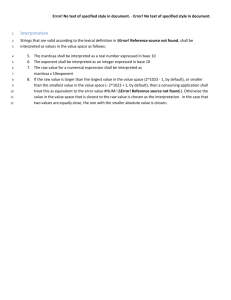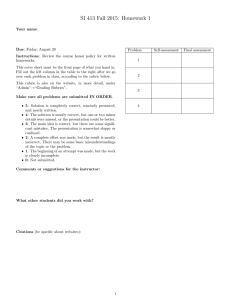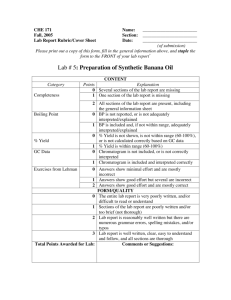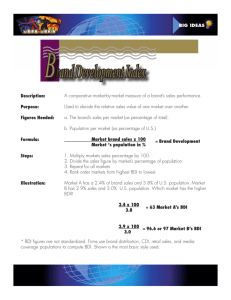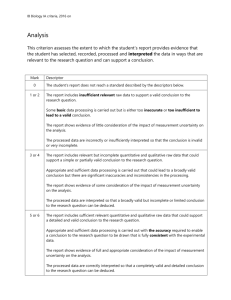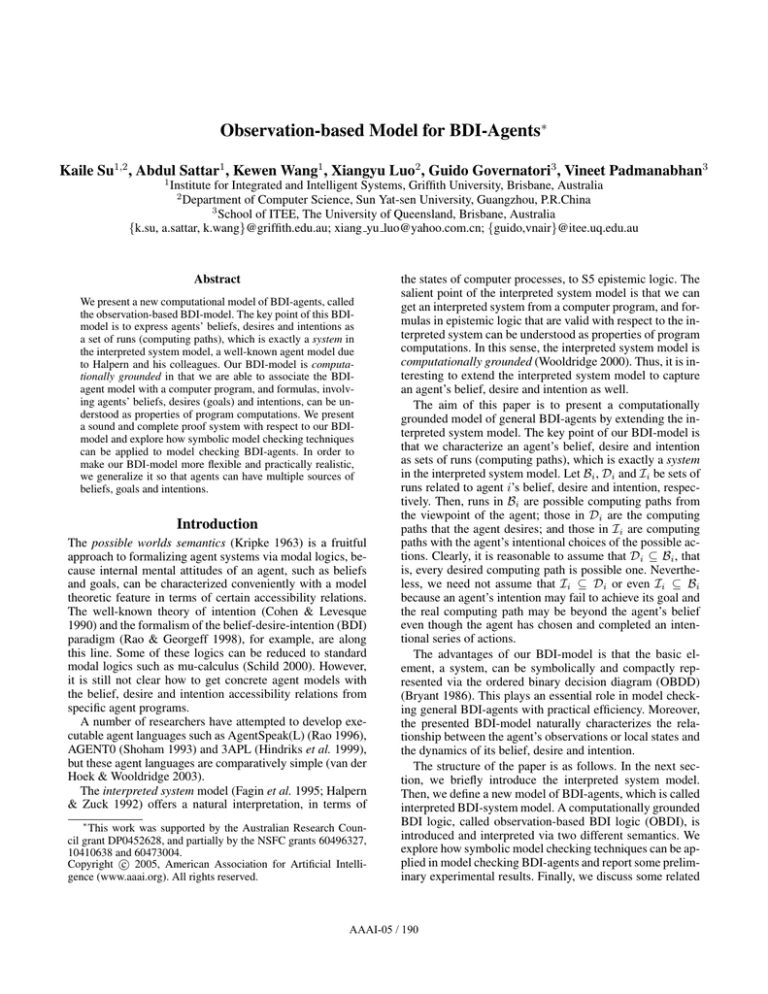
Observation-based Model for BDI-Agents∗
Kaile Su1,2 , Abdul Sattar1 , Kewen Wang1 , Xiangyu Luo2 , Guido Governatori3 , Vineet Padmanabhan3
Institute for Integrated and Intelligent Systems, Griffith University, Brisbane, Australia
2
Department of Computer Science, Sun Yat-sen University, Guangzhou, P.R.China
3
School of ITEE, The University of Queensland, Brisbane, Australia
{k.su, a.sattar, k.wang}@griffith.edu.au; xiang yu luo@yahoo.com.cn; {guido,vnair}@itee.uq.edu.au
1
Abstract
We present a new computational model of BDI-agents, called
the observation-based BDI-model. The key point of this BDImodel is to express agents’ beliefs, desires and intentions as
a set of runs (computing paths), which is exactly a system in
the interpreted system model, a well-known agent model due
to Halpern and his colleagues. Our BDI-model is computationally grounded in that we are able to associate the BDIagent model with a computer program, and formulas, involving agents’ beliefs, desires (goals) and intentions, can be understood as properties of program computations. We present
a sound and complete proof system with respect to our BDImodel and explore how symbolic model checking techniques
can be applied to model checking BDI-agents. In order to
make our BDI-model more flexible and practically realistic,
we generalize it so that agents can have multiple sources of
beliefs, goals and intentions.
Introduction
The possible worlds semantics (Kripke 1963) is a fruitful
approach to formalizing agent systems via modal logics, because internal mental attitudes of an agent, such as beliefs
and goals, can be characterized conveniently with a model
theoretic feature in terms of certain accessibility relations.
The well-known theory of intention (Cohen & Levesque
1990) and the formalism of the belief-desire-intention (BDI)
paradigm (Rao & Georgeff 1998), for example, are along
this line. Some of these logics can be reduced to standard
modal logics such as mu-calculus (Schild 2000). However,
it is still not clear how to get concrete agent models with
the belief, desire and intention accessibility relations from
specific agent programs.
A number of researchers have attempted to develop executable agent languages such as AgentSpeak(L) (Rao 1996),
AGENT0 (Shoham 1993) and 3APL (Hindriks et al. 1999),
but these agent languages are comparatively simple (van der
Hoek & Wooldridge 2003).
The interpreted system model (Fagin et al. 1995; Halpern
& Zuck 1992) offers a natural interpretation, in terms of
This work was supported by the Australian Research Council grant DP0452628, and partially by the NSFC grants 60496327,
10410638 and 60473004.
c 2005, American Association for Artificial IntelliCopyright °
gence (www.aaai.org). All rights reserved.
∗
the states of computer processes, to S5 epistemic logic. The
salient point of the interpreted system model is that we can
get an interpreted system from a computer program, and formulas in epistemic logic that are valid with respect to the interpreted system can be understood as properties of program
computations. In this sense, the interpreted system model is
computationally grounded (Wooldridge 2000). Thus, it is interesting to extend the interpreted system model to capture
an agent’s belief, desire and intention as well.
The aim of this paper is to present a computationally
grounded model of general BDI-agents by extending the interpreted system model. The key point of our BDI-model is
that we characterize an agent’s belief, desire and intention
as sets of runs (computing paths), which is exactly a system
in the interpreted system model. Let Bi , Di and Ii be sets of
runs related to agent i’s belief, desire and intention, respectively. Then, runs in Bi are possible computing paths from
the viewpoint of the agent; those in Di are the computing
paths that the agent desires; and those in Ii are computing
paths with the agent’s intentional choices of the possible actions. Clearly, it is reasonable to assume that Di ⊆ Bi , that
is, every desired computing path is possible one. Nevertheless, we need not assume that Ii ⊆ Di or even Ii ⊆ Bi
because an agent’s intention may fail to achieve its goal and
the real computing path may be beyond the agent’s belief
even though the agent has chosen and completed an intentional series of actions.
The advantages of our BDI-model is that the basic element, a system, can be symbolically and compactly represented via the ordered binary decision diagram (OBDD)
(Bryant 1986). This plays an essential role in model checking general BDI-agents with practical efficiency. Moreover,
the presented BDI-model naturally characterizes the relationship between the agent’s observations or local states and
the dynamics of its belief, desire and intention.
The structure of the paper is as follows. In the next section, we briefly introduce the interpreted system model.
Then, we define a new model of BDI-agents, which is called
interpreted BDI-system model. A computationally grounded
BDI logic, called observation-based BDI logic (OBDI), is
introduced and interpreted via two different semantics. We
explore how symbolic model checking techniques can be applied in model checking BDI-agents and report some preliminary experimental results. Finally, we discuss some related
AAAI-05 / 190
work and conclude this paper.
Preliminaries
We start by giving some notions concerning the interpreted
system model. Consider a system composed of multiple
agents in an environment. We represent the system’s state
or the global state as a tuple (se , s1 , · · · , sn ), where se is
the environment’s local state and, for each i, si is agent i’s
local state.
Let Le be a set of possible local states of the environment and Li a set of possible local states for agent i, for
i = 1, · · · , n. We take G ⊆ Le × L1 × · · · × Ln to be the
set of reachable global states of the system. A run over G
is a function from the time domain–the natural numbers in
our case–to G. Thus, a run over G can be identified with a
sequence of global states in G. For convenience, we use g ∗
to denote the sequence of infinitely repeated global state g;
so, g0 g1∗ , for example, indicates a run with the initial state g0
followed by infinitely repeated state g1 .
We refer to a pair (r, m) consisting of a run r and time m
as a point. Given a point (r, m), we denote the first component of the tuple r(m) by re (m) and, for each i (1 ≤ i ≤ n),
the i + 1’th component of the tuple r(m) by ri (m). Thus,
ri (m) is the local state of agent i in run r at “time” m.
The idea of the interpreted system semantics is that a run
represents one possible computation of a system and a system may have a number of possible runs, so we say a system
is a set of runs.
Assume that we have a set Φ of primitive propositions,
which we can think of as describing basic facts about the
system. An interpreted system I consists of a pair (R, π),
where R is a set of runs over a set of global states and π is a
valuation function, which gives the set of primitive propositions true at each point in R (Fagin et al. 1995).
For every agent i, let (r, u) ∼i (r0 , v) denote that
ri (u) = ri0 (v). Intuitively, (r, u) ∼i (r0 , v) means that
(r, u) and (r 0 , v) are indistinguishable to agent i. We also
use (r, u) ∼spr
(r0 , v) to denote u = v and, for every j ≤ u,
i
ri (j) = ri0 (j) (here spr stands for synchronous systems with
perfect recall ).
Let KLn denote the language of propositional logic augmented by the future-time connectives ° (next) and U (until) and a modal operator Ki for each agent i. The language KLn can be interpreted by using an interpreted system. The related satisfaction relationship |=KLn is as follows: Given I = (R, π) and a point (r, u) in R, we define (I, r, u) |=KLn ψ by induction on the structure of
ψ. When ψ is of the form Ki ϕ, (I, r, u) |=KLn ψ iff
(I, r 0 , v) |=KLn ϕ for all (r 0 , v) such that (r, u) ∼i (r0 , v).
It may also be standardly dealt with when ψ is atomic or of
the form ¬ϕ, ϕ ∧ ϕ0 , °ϕ or ϕUϕ0 .
The Interpreted BDI-system Model
In this section, we present a new model of BDI-agents,
called the interpreted BDI-system model, which extends the
interpreted system model. The key point of our approach is
that we define agents’ belief, desire and intention as sets of
runs, that is, systems in the interpreted system model.
Formally, given a set G of global states and system K over
G, an agent’s mental state over system K is a tuple hB, D, Ii,
where B, D and I are systems (sets of runs over G) such
that I ⊆ K and D ⊆ B ⊆ K. A BDI-system is a structure
hK, M1 , · · · , Mn i, where K is a system and for every i, Mi
is agent i’s mental state over K.
Assume that we have a set Φ of primitive propositions,
which we can think of as describing basic facts about our
BDI-agents and their environment. An interpreted BDIsystem I consists of a pair (S, π), where S is a BDI-system
and π is a valuation function, which gives the set of primitive
propositions true at each point in G.
Example 1 Let us consider the scenario of a robot cleaning a
room. There are two global states: s0 and s1 . In state s0 , the
room is dirty, and in state s1 , the room is clean. Moreover,
the robot believes that the room is dirty, and the goal of the
robot is to clean the room.
Now we define a BDI-system S0 =hK0 , hB0 , D0 , I0 ii,
where
• K0 is the set of those runs r such that, for every natural
number m, if r(m) = s1 then r(m + 1) = s1 , which
means that if the room is clean, then it will keep so.
• B0 is a set of those runs r ∈ K0 with r(0) = s0 . This
means that the robot believes the room is dirty at first.
Notice that belief is just the information state of the robot,
and there is no guarantee that robot will make the room
clean.
• D0 is a subset of B0 such that, for every run r ∈ D0 , there
is a number m with r(m) = s1 . This means that the robot
desires to clean the room.
• Finally, we may define I0 to be the set of runs s0 s1 ∗ and
s1 ∗ . This indicates the robot will clean the room immediately.
We may take {dirty} as the set Φ of primitive propositions, representing whether the room is clean or dirty.
Clearly, we may naturally define π0 (s0 )(dirty) = 0 and
π0 (s1 )(dirty) = 1. Thus, we get the interpreted BDI-system
(S0 , π0 ).
OBDI Logic
In this section, we introduce a multimodal logic of belief,
desire and intention, referred to as Observation-based BDI
logic (OBDI). As shown below, the semantics of OBDI logic
is given in terms of the interpreted BDI-system model illustrated above; According to this semantics, the computation of agents’ beliefs, desires, and intentions are based on
agents’ observations (i.e. local states).
Syntax
Given a set Φ of propositional atoms, the language of OBDI
logic is defined by the following BNF notations:
hwf f i ::=
any element of Φ | ¬hwf f i | hwf f i ∧ hwf f i |
°hwf f i | hwf f iUhwf f i |
| Bi hwf f i | Di hwf f i | Ii hwf f i
Informally, Bi ϕ and Di ϕ means that agent i believes and
desires ϕ, respectively, while Ii ϕ denotes that ϕ holds un-
AAAI-05 / 191
der the assumption that agent i acts based on his intention. The formulas not containing modalities Bi , Di and Ii
(i = 1, · · · , n) are called LT L formulas.
Semantics
We now proceed to interpret OBDI logic formulas in terms
of interpreted BDI-systems. In what follows, we inductively
define the satisfaction relation |=BDI between a formula ϕ
and a pair of interpreted BDI-system and a point. Given
an interpreted BDI-system I = (S, π), suppose that S =
hK, M1 , · · · , Mn i and for every i, Mi = hBi , Di , Ii i. Let
r be a run in K and u a natural number, then we have that:
• (I, r, u) |=BDI Bi ϕ iff (I, r 0 , v) |=BDI ϕ for those (r 0 , v)
such that r 0 ∈ Bi and (r, u) ∼i (r0 , v);
• (I, r, u) |=BDI Di ϕ iff (I, r 0 , v) |=BDI ϕ for those (r 0 , v)
such that r 0 ∈ Di and (r, u) ∼i (r0 , v);
• (I, r, u) |=BDI Ii ϕ iff (I, r 0 , v) |=BDI ϕ for those (r 0 , v)
such that r 0 ∈ Ii and (r, u) ∼i (r0 , v);
• (I, r, u) |=BDI °ϕ iff (I, r, (u + 1)) |=BDI ϕ;
• (I, r, u) |=BDI ϕUϕ0 iff (I, r, u0 ) |=BDI ϕ0 for some u0 ≥ u
and (I, r, u00 ) |=BDI ϕ for all u00 with u ≤ u00 < u0 .
Other cases are trivial and omitted here. We say that a
formula ϕ is valid in an interpreted BDI system I, denoted
by I |=BDI ϕ, if (I, r, u) |=BDI ϕ holds for every point
(r, u) in I. We use |=BDI ϕ to denote that ϕ is valid in
every interpreted BDI-system.
According to our definition, Di ϕ is true iff ϕ is true along
those runs that are desirable to agent i and consistent to agent
i’s observation. Thus, Di ϕ intuitively means that agent i’s
goal implies that ϕ holds.
For those agents with perfect recall and a global clock, we
may use ∼spr
instead of ∼i to interpret those formals with
i
modalities Bi , Di and Ii and get an alternative satisfaction
relationship |=spr
BDI .
Proposition 2 The following formulas are valid with respect to both |=BDI and |=spr
BDI :
• X(ϕ ⇒ ψ) ⇒ (Xϕ ⇒ Xψ)
Xϕ ⇒ Y Xϕ
¬Xϕ ⇒ Y ¬Xϕ
where X and Y stand for Bi , Di or Ii (for the same i).
• Relationship between belief and desire
Bi ϕ ⇒ D i ϕ
• Temporal operators
Axiomatization
We give a proof system, called OBDI proof system, for those
BDI-agents with perfect recall and a global clock, which
contains the axioms of propositional calculus plus those formulas in Propositions 2 and 3. The proof system is closed
`ϕ
`ϕ
under the propositional inference rules plus: `D
and `I
iϕ
iϕ
for every agent i.
Theorem 4 The OBDI proof system for agents with perfect
recall and a global clock is sound and complete with respect
to interpreted BDI-systems with satisfaction relation |=spr
BDI .
Proof: The soundness part is easy and the completeness can
follow the similar lines as (Halpern, van der Meyden, &
Vardi 2004).
Rational Interpreted BDI-Systems
The drawback of the presented approach is that it is possible for an agent in our BDI-model to have inconsistent beliefs, goals, and intentions. This is because each agent has
only single source of belief, single goal and single intention,
which may conflict to the agent’s observations. To make our
model more rational, we assume that agents have multiple
sources of beliefs, multiple goals and multiple intentions.
Formally, given a set G of global states and system K over
G, agent i’s BDI-state over system K is defined to be a tuple
Mi = hBi1 , · · · , Bik1 , Di1 , · · · , Dik2 , Ii1 , · · · , Iik3 i,
where Bij , Dij and Iij are subsets of K. The structure S =
hK, M1 , · · · , Mn i is said to be a rational BDI-system. And
similarly, given a valuation function π, we call the pair I =
(S, π) a rational interpreted BDI-system.
We may interpret OBDI logic formulas in terms of rational interpreted BDI-systems as follows. Denote the satisfaction relation by |=RBDI . Given the rational interpreted
BDI-system I as above, run r and number u, let j1 be
the least number j such that there is a point (r 0 , v) with
(r, u) ∼i (r0 , v) and r 0 ∈ Bij . Let j2 be the least number
j such that (1) Dij ⊆ Bij1 ; and (2) there is a point (r 0 , v) and
0
number j 0 with (r, u) ∼i (r0 , v) and r 0 ∈ Dij ∩ Iij . Let j3
be the least number j such that there is a point (r 0 , v) with
(r, u) ∼i (r0 , v) and r 0 ∈ Dij2 ∩ Iij . Intuitively, agent i first
determines her source of belief (the j1 th one). Then, agent i
chooses her goal j2 . In order to achieve goal j2 , agent i acts
by the intention j3 . Thus, we define
• (I, r, u) |=RBDI Bi ϕ iff (I, r 0 , v) |=RBDI ϕ for those (r 0 , v)
such that r 0 ∈ Bij1 and (r, u) ∼i (r0 , v);
°(ϕ ⇒ ψ) ⇒ (°ϕ ⇒ °ψ)
°(¬ϕ) ⇒ ¬ ° ϕ
ϕUψ ⇔ ψ ∨ (ϕ ∧ °(ϕUψ))
Proposition 3 The following formulas are valid with respect to |=spr
BDI : X ° ϕ ⇒ °Xϕ, where X stands for any
modality of Bi , Di and Ii (i = 1, · · · , n).
The formula Di ° ϕ ⇒ °Di ϕ says that if agent i’s
current goal implies ϕ holds next time, then at the next time
her goal will imply ϕ, in other words, agent i persists on her
goal.
• (I, r, u) |=RBDI Di ϕ iff (I, r 0 , v) |=RBDI ϕ for those (r 0 , v)
such that r 0 ∈ Dij2 and (r, u) ∼i (r0 , v);
• (I, r, u) |=RBDI Ii ϕ iff (I, r 0 , v) |=RBDI ϕ for those (r 0 , v)
such that r 0 ∈ Iij3 and (r, u) ∼i (r0 , v).
Under some constraints, the rational interpreted BDIsystem model results in more rational properties of BDIagents (For example, agents could update or change her belief by her observations and make her belief consistent).
AAAI-05 / 192
Model Checking BDI-Agents
The model checking problem for our OBDI logic is quite
simple: given an interpreted BDI-system I and an OBDI formula ϕ, determine whether or not I |=BDI ϕ.
In order to make our model checking algorithm practically useful, we must consider where our model, an interpreted BDI-system comes from. It would be satisfying if we
can derive our model from a program implemented in, say C
or Java. However, to make the things simpler, we may consider some abstract programs such as finite-state programs,
which is expressive enough from the standpoint of theoretical computer science. Moreover, to make our model checking system practically efficient, we use the symbolic model
checking techniques. Thus, a finite-state program in our approach is represented in a symbolic way.
Symbolic representation of interpreted BDI-agents
A system as a set of infinite runs is not well suited to model
checking directly as it is generally applied to the finite state
systems. However, we can represent an interpreted system
as a finite-state program (G, G0 , R, V ), where G is a set of
states, G0 a set of initial states, and R a total “next time”
relation, and V associates each state with a truth assignment
function. A set of infinite runs is then obtained by “unwinding” the relation R starting from initial states in G0 .
More significantly, we can present a symbolic representation of a finite-state program (G, G0 , R, V ) as follows.
1. We use a tuple of boolean variables x = {x1 , · · · , xk }
and encode a state as an assignment for x, or a subset
of x. (For convenience, we do not distinguish a set and
its characteristic function.) Thus, G0 and any set of states
can be represented as a propositional formula over x.
2. Another tuple of boolean variables x0 = {x01 , · · · , x0k } is
used to represent the “next time” relation R between two
states as a propositional formula τ over x ∪ x0 . Specifically, for two assignments s and s0 for x, sRs0 holds iff
τ (x, x0 ) is satisfied by the assignment s ∪ N (s0 ), where
N (s0 ) denotes {x0j | xj ∈ s0 and 0 < j ≤ k}.
3. We assume that for each s, V (s) equals s, that is, for each
variable xj (1 ≤ j ≤ k), V (s)(xj ) = 1 iff s(xj ) = 1.
Omitting the component V , we represent the finite-state program (G, G0 , R, V ) just as (x, θ(x), τ (x, x0 )).
Hence, we formally define a (symbolic) finitestate program with n agents as a tuple P
=
(x, θ(x), τ (x, x0 ), O1 , · · · , On ), where
1. x is a set of system variables;
2. θ is a boolean formula over x, called the initial condition;
3. τ is a boolean formula over x ∪ x0 , called the transition
relation; and
4. for each i, Oi ⊆ x, containing agent i’s local variables,
or observable variables.
Given a state s, we define agent i’s local state at state s to be
s ∩ Oi . For convenience, we denote (s, s ∩ O1 , · · · , s ∩ On )
by g(s). We associate with P the interpreted system IP =
(R, π), where R is a set of those runs r satisfying that
1. for each m, r(m) is of the form g(s) = (s, s∩O1 , · · · , s∩
On ) where s is a state in P and the assignment π(s) is the
same as s;
2. r(0) is g(s) for some assignment s that satisfies θ;
3. for each natural number m, if r(m) = g(s) and r(m +
1) = g(s0 ) for some assignments s and s0 for x , then
s ∪ N (s0 ) is an assignment satisfying τ (x, x0 ).
The interpreted system IP is called the generated interpreted system of P.
For convenience, we may use P(θ, τ ) to
denote a finite-state program with n agents
(x, θ(x), τ (x, x0 ), O1 , · · · , On ), if x and O1 , · · · , On
are clear from the context.
Given a finite-state program P(θ, τ ) with n agents , we
define an agent’s internal program over P(θ, τ ) as a tuple hP(θ1 , τ1 ), P(θ2 , τ2 ), P(θ3 , τ3 )i, where, for j = 1, 2, 3,
(θj ⇒ θ) ∧ τj ⇒ τ is valid, and (θ2 ⇒ θ1 ) ∧ τ2 ⇒ τ1 is
valid.
Clearly, an agent’s internal program is exactly related with
an agent’s mental state. Thus, we define a (symbolic ) BDIprogram with n agents as a tuple PA = (PK , P1 , · · · , Pn ),
where PK is a finite-state program with n agents and for
each agent i, Pi is agent i’s internal program over PK .
We use IPA to denote the corresponding interpreted BDIsystem.
Model checking OBDI logic
We need to introduce some notations concerning building
boolean formulas. Given a propositional variable p, and a
formula ϕ, we use ∃pϕ and ∀pϕ to denote ϕ[true/p] ∨
ϕ[false/p] and ϕ[true/p]∧ϕ[false/p], respectively, where
true is some valid boolean formula and false is the negation
of true. For a set of boolean variables v = {v1 , · · · , vm },
∃vϕ (∀vϕ) stand for ∃v1 · · · ∃vm ϕ (∀v1 · · · ∀vm ϕ).
Let ξ be an operator from the set of boolean formulas over
x to the set of boolean formulas over x. We say ψ is a fixed
point of ξ, if |= ξ(ψ) ⇔ ψ. We say a formula ψ0 is a greatest
fixed point of ξ, if ψ0 is a fixed point of ξ and for every fixed
point ψ of ξ, we have that |= ψ ⇒ ψ0 . Clearly, any two
greatest fixed points are logically equivalent to each other.
Thus, we denote a greatest fixed point of ξ by gfpZξ(Z).
Similarly, we say a ψ0 is a least fixed point of ξ, if ψ0 is a
fixed point of ξ and for every fixed point ψ of ξ, we have that
|= ψ0 ⇒ ψ. A least fixed point of ξ is denoted by lfpZξ(Z).
To prove the main result in this section, we need the following two lemmas:
Lemma 5 Given boolean formula ψ over x and a subset V
of x, an assignment (subset) s of x, suppose that, for every
s0 |= ψ, we have s ∩ V 6= s0 ∩ V , then s |= ∀(x − V )(¬ψ).
The proof of the above lemma is easy in that it concerns
only boolean formulas and their assignments.
Given a finite-state program P(θ, τ ) with n agents, let
G(P(θ, τ )) = lfpZ [θ(x) ∨ (∃x(Z ∨ τ (x, x0 )))[x/x0 ]] . The
boolean formula G(P(θ, τ )) expresses the set of reachable
global states .
The next lemma is a variation of Proposition 10 in (Su
2004), whose validity can be seen from the proof of that
proposition.
AAAI-05 / 193
Lemma 6 Given a finite-state program with n agents
(x, θ(x), τ (x, x0 ), O1 , · · · , On ) and an LT L formula ϕ,
Then, IP |=KLn Ki ϕ ⇔ ∀(x − Oi )(G(P(θ, τ )) ⇒ Γ(ϕ, θ, τ ))
where Γ(ϕ, θ, τ ) is a boolean formula built from ϕ, θ, τ by
using quantifications and fixed-point operations lft and gft.
Notice that some new propositional variables may be introduced in Γ(ϕ, θ, τ ), but Γ(ϕ, θ, τ ) has no free propositional variables other than x. We omit the details of formula Γ(ϕ, θ, τ ), but what is significant is that Γ(ϕ, θ, τ ) is
an expression built by boolean operators and quantifications
over propositional variables as well as fixed-point operators.
Such expressions can be conveniently dealt with by OBDD
as done in main stream computer science.
Theorem 7 Given a BDI-program with n agents
PA
=
(PK , P1 , · · · , Pn ), suppose that PK
=
(x, θ(x), τ (x, x0 ), O1 , · · · , On ), and for every i,
Pi = hP(θ1i , τ1i ), P(θ2i , τ2i ), P(θ3i , τ3i )i. Then, for each
LT L formula ϕ and agent i, the following are valid in IPA ,
1. Bi ϕ ⇔ ∀(x − Oi )(G(P(θ1i , τ1i )) ⇒ Γ(ϕ, θ1i , τ1i ))
2. Di ϕ ⇔ ∀(x − Oi )(G(P(θ2i , τ2i )) ⇒ Γ(ϕ, θ2i , τ2i ))
3. Ii ϕ ⇔ ∀(x − Oi )(G(P(θ3i , τ3i )) ⇒ Γ(ϕ, θ3i , τ3i ))
Proof: We prove only the first one, the other two can be
obtained in a similar way. Let r be a run in the interpreted
system IPK , m a natural number. To show the formula
Bi ϕ ⇔ ∀(x − Oi )(G(P(θ1i , τ1i )) ⇒ Γ(ϕ, θ1i , τ1i ))
is valid in (IPA , r, m), we first consider the case that for
every point (r 0 , m0 ) in the interpreted system IP(θ1i ,τ1i ) , we
have r(m) ∩ Oi 6= r0 (m0 ) ∩ Oi , i.e., ri (m) 6= ri0 (m0 ). In this
case, we have that IPA , r, m |=BDI Bi ϕ. On the other hand,
for every assignment s0 over x with s0 |= G(P(θ1i , τ1i )),
there is a point (r 0 , m0 ) in IP(θ1i ,τ1i ) with s0 = r0 (m0 ), and
we thus have that r(m) ∩ Oi 6= s0 ∩ Oi . Therefore, we
have that r(m) |= ∀(x − Oi )(¬G(P(θ1i , τ1i )) (by Lemma 5),
and hence IPA , r, m |=BDI ∀(x − Oi )(G(P(θ1i , τ1i )) ⇒
Γ(ϕ, θ1i , τ1i )) holds. Thus, the claim holds in this case.
Suppose that for some point (r 0 , m0 ) in the interpreted
system IP(θ1i ,τ1i ) , we have r(m) ∩ Oi = r0 (m0 ) ∩ Oi ,
i.e., ri (m) = ri0 (m0 ). Then, it is clear that ∀(x −
Oi )(G(P(θ1i , τ1i )) ⇒ Γ(ϕ, θ1i , τ1i )) has the same truth value
in (IPA , r, m) and in (IPA , r0 , m0 ). By the semantics definition, we have that Bi ϕ has the same truth value in
(IPA , r, m) and in (IPA , r0 , m0 ). Thus, we only need to show
that the validity of Bi ϕ ⇔ ∀(x − Oi )(G(P(θ1i , τ1i )) ⇒
to that ¶
Γ(ϕ, θ1i , τ1i )) in (IPA , r0 , m0 ), which is equivalent
µ
i
i
IP(θi ,τ i ) , r0 , m0 |=KLn Ki ϕ ⇔ ∀(x−Oi )
1
1
G(P(θ1 , τ1 ))
⇒ Γ(ϕ, θ1i , τ1i )
because r 0 is a run in the interpreted system IP(θ1i ,τ1i ) . Thus,
the claim holds in this case also.
Experimental Results
Theorem 7 provides a reduction of OBDI to LT L, while
Proposition 9 in (Su 2004) gives an OBDD-based method
of model checking LT L formulas. The complexity of our
reduction of logic OBDI to LT L is P SP ACE-complete.
However, because the quantification of Boolean functions
and fixed-point operators can be dealt with by any OBDD
package, the reduction can be based on OBDDs. Thus, the
OBDI model checking algorithm with the above results can
be implemented with considerable efficiency.
In this study, we implemented a prototype of the OBDI
model checker using CUDD library developed by Fabio
Somenzi, and obtained preliminary experimental results.
The scenario we use here involves two robots that are
cleaning 9 squares in a 3x3 square, some of which are dirty.
We assume that Robot r1 has initial belief about which
squares are dirty. Robot r1 searches for dirty squares according to her belief; and when one is found, the robot calls
robot r2 to go to the location of the dirty square and then
they clean the dirty square together. After cleaning the dirty
square, r2 remains at the same location, and r1 looks for
another dirty square.
As our system is OBDD based, we describe interpreted
systems (basic elements in our BDI-model) by the language
similar to the input language of the very influential model
checking tool NuSMV based on OBDD.
The environment consists of a Boolean array d[1..3][1..3]
indicating the dirty squares and a Boolean variable
calling, which expresses that r1 is calling r2.
An agent is defined as a module, which consists of a set
of observable variables and three submodules for the agent’s
beliefs, desires and intentions, respectively. The observable
variables includes all of the variables defined in the module and the formal parameters explicitly labelled observable
(e.g., one agent’s observable parameters includes the other’s
position and calling). Each submodule includes a set of
triggering events and its corresponding actions, and shares
the observable variables and the initial beliefs of its main
module. An action will be executed once its event is triggered and the context for the action is satisfied based on the
agent’s current beliefs. We omit the modelling details here.
Assume that the initial state is d[1][3]∧¬d[2][1]∧d[3][3] and
agent r1 initially believes that positions (1, 3), (2, 1) and
(3, 3) are dirty. The model checker verified the following
specifications by using a PC with CPU P4 2.4G and memory
512M.
1. G((B1 d[3][3]) ⇒ F(¬d[3][3]) ∧ pos(r1, 3, 3) ∧ pos(r2, 3, 3))
Result: true, BDD nodes allocated: 313240, Time: 0.68s.
2. G((pos(r1, 3, 3) ∧ clean(r1, 3, 3)) => D1 (Fcontinue))
Result: true, BDD nodes allocated: 357293, Time: 1.04s.
3. F(I1 goto(r1, 2, 1) ∧ F clean(r1, 2, 1))
Result: false, BDD nodes allocated: 288275, Time: 0.60s.
where Fϕ ≡ trueUϕ and Gϕ ≡ ¬F¬ϕ. The first specification says that in any situation, if r1 believes that (3, 3)
is dirty, then r1 and r2 will go there and clean it eventually. The second indicates that in any situation, if r1 is at
square (3, 3) and will clean it next time, then she desires to
continue the search. The third means that r1 will eventually
clean square (2, 1) once she intends to go there. It is false,
because r1 need not clean (2, 1) after she detects that it is
actually clean.
Related Work
Computationally grounded logics: Besides epistemic
logic with the interpreted system model, another computa-
AAAI-05 / 194
tionally grounded logic is VSK logic (Wooldridge & Lomuscio 2001). However, belief, desire or intention of an
agent is not considered in VSK; the technical difficulty behind this seems that modalities for those notions do not satisfy S5 axioms. Thus, it is interesting to formalize the internal attitudes of an agent by extending the interpreted system
model.
Alternating-time temporal logics: Alternating-time temporal logic (ATL) and its extensions (ATEL, for example)
were proposed recently to tackle the verification of multiagent system properties (Alur, Henzinger, & Kupferman
2002; van der Hoek & Wooldridge 2002). Using ATL one
can express that a coalition of agents can achieve some properties. For example, assume that p and q are local variables
of agents 1 and 2, respectively; a coalition of agents 1 and
2 can achieve p ⇔ q. Nevertheless, there is no practical
strategy to guarantee that p ⇔ q, because agent 1 can only
observe and change the value of p and so can agent 2 for
variable q. It is not very convenient to use ATL to deal with
incomplete information or agents’ local observations, as the
model checking problem of ATL with incomplete information is generally undecidable (Alur, Henzinger, & Kupferman 2002). Moreover, ATL and its extensions do not deal
with agents’ mental state such as belief and desire.
Model checking BDI-agents: Model checking multiagents systems has become an active topic in the community of multi-agents systems. Many efforts have been devoted to model checking knowledge in multi-agents systems
(Hoek & Wooldridge 2002; van der Meyden & Su 2004;
Su 2004; Raimondi & Lomuscio 2004). However, comparatively little work has been carried out on model checking BDI-agents. Some general approaches to model checking BDI-agents were proposed in (Rao & Georgeff 1993;
Benerecetti & Cimatti 2002), but no method was given for
generating models from actual systems, and so the techniques given there could not easily be applied to verifying
real multi-agent systems. In (Bordini et al. 2003), model
checking techniques for AgentSpeak(L) (Rao 1996) were reported; however, AgentSpeak(L) has very simple semantics.
The salient point of our work is that we present a general
form of BDI agent program, from which BDI agent models
are generated and specifications in full BDI logics can be
verified by symbolic model checking techniques.
Concluding Remarks
We have proposed a new BDI-model by using interpreted
systems, and developed a computationally grounded BDI
logic, called OBDI logic. We interpret OBDI logic via two
different semantics. One of them is based on the assumption
that agents have perfect recalls and a global clock, with respect to which a sound and complete proof system has been
presented. We have explored how symbolic model checking
techniques can be applied to model checking BDI-agents
and got some preliminary experimental results. As for future work, we plan to further investigate rational interpreted
BDI-systems and to link to known axiomatizations of belief,
desire, and intention.
References
Alur, R.; Henzinger, T.; and Kupferman, O. 2002. Alternatingtime temporal logic. Journal of the ACM 49:672–713.
Benerecetti, M., and Cimatti, A. 2002. Symbolic model checking
for multi-agent systems. In Proc. MoChart-02, 1–8.
Bordini, R.; Fisher, M.; Pardavila, C.; and Wooldridge, M. 2003.
Model checking agentspeak. In Proc. AAMAS-03, 14–18.
Bryant, R. 1986. Graph-based algorithms for boolean function
manipulation. IEEE Transaction on Computers (C-35(8)).
Cohen, P., and Levesque, H. 1990. Intension is choice with commitment. Artificial Intelligence 42:23–261.
Fagin, R.; Halpern, J.; Moses, Y.; and Vardi, M. 1995. Reasoning
about knowledge. Cambridge, MA: MIT Press.
Halpern, J., and Zuck, L. 1992. A little knowledge goes a long
way: Simple knowledge based derivations and correctness proofs
for a family of protocols. Journal of the ACM 39(3):449–478.
Halpern, J.; van der Meyden, R.; and Vardi, M. Y. 2004. Complete
axiomatizations for reasoning about knowledge and time. SIAM
Journal of Computing 33(3):647–703.
Hindriks, K.; de Boer, F.; van der Hock, W.; and Meyer, J.-J. C.
1999. Agent programming in 3apl. Autonomous Agents and
Multi-Agent Systems 2(4):357–402.
Hoek, W. v. d., and Wooldridge, M. 2002. Model checking knowledge and time. In 9th Workshop on SPIN (Model Checking Software).
Kripke, S. 1963. A semantical analysis of modal logic. i: Normal
modal propositional calculi. Z. Math. Logik Grundl. Math. 9:67–
96.
Raimondi, F., and Lomuscio, A. 2004. Verification of multiagent
system via ordered binary decision diagrams: an algorithm and its
implementation. In Proc. of AAMAS-04.
Rao, A., and Georgeff, M. 1993. A model theoretic approach to
the verification of situated reasoning systems. In Proc. 13th International Joint Conference on Artificial Intelligence, 318–324.
Rao, A., and Georgeff, M. 1998. Decision procedures for BDI
logics. Journal of Logic and Computation 8(3):293–344.
Rao, A. 1996. Bdi agent speak out in a logical computable language. In LNAI, volume 1038, 42–55.
Schild, K. 2000. On the relationship between BDI logics and
standard logics of concurrency. Autonomous Agents and MultiAgent Systems 3:259–283.
Shoham, Y. 1993. Agent oriented programming. Artificial Intelligence 60(1):51–92.
Su, K. 2004. Model checking temporal logics of knowledge in
distributed systems. In AAAI-04, 98–103. AAAI.
van der Hoek, W., and Wooldridge, M. 2002. Tractable multiagent planning for epistemic goals. In Proc. AAMAS-02, 1167–
1174.
van der Hoek, W., and Wooldridge, M. 2003. Towards a logic of
rational agency. L.J. of IGPL 11(2):135–159.
van der Meyden, R., and Su, K. 2004. Symbolic model checking
the knowledge of the dining cryptographers. In Proc. of IEEE
CSFW-04, 280–291.
Wooldridge, M., and Lomuscio, A. 2001. A computationally
grounded logic of visibility, perception, and knowledge. Logic
Journal of the IGPL 9(2):273–288.
Wooldridge, M. 2000. Computationally grounded theories of
agency. In Durfee, E., ed., ICMAS-00, 13–22. IEEE Press.
AAAI-05 / 195

